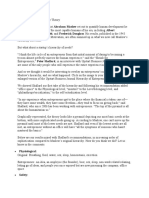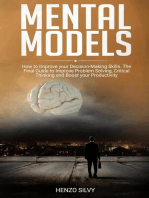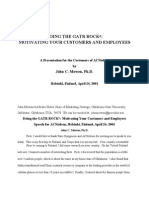Business Models & Ideation
Business Models & Ideation
Uploaded by
chuCopyright:
Available Formats
Business Models & Ideation
Business Models & Ideation
Uploaded by
chuCopyright
Available Formats
Share this document
Did you find this document useful?
Is this content inappropriate?
Copyright:
Available Formats
Business Models & Ideation
Business Models & Ideation
Uploaded by
chuCopyright:
Available Formats
MN3194 Entrepreneurship (online)
Block 5: Business Models & Ideation
This block begins with a video on the VLE you can access it here:
https://www.youtube.com/watch?v=R6T3GKjNXM8
Aim of the chapter
The aims of this block are as follows:
• Learn how to develop a business idea
• Learn to develop a business model
• Comprehend the principle of developing a business model on the basis of Maslow’s pyramid
of needs
• Understand the most common business models
Learning Outcomes
By the end of this chapter, and having completed the essential reading and completed the activities
you should be able to:
• Have a business idea
• Have a business model
• Be able to explain the difference between the two
• Be able to explain the five basic human needs
• Be able to analyse the business model of firms
• Understand the principle of product-market fit
• Understand the difference between need and demand
Reading list
Essential reading/viewing
Maslow, A.H. A Theory of Human Motivation. Originally Published in Psychological Review, 50,
370-396. Available at Classics in the History of Psychology. (Washington:
1943) https://psychclassics.yorku.ca/Maslow/motivation.htm
Kuppers, M. Startup Manufactory Business Model & MVP Development. Available on
Slideshare https://www.slideshare.net/MattKuppers1/startup-manufactory-business-model-mvp-
development. (London: Startup Manufactory, 2016)
References cited:
Maslow, A.H. A Theory of Human Motivation. Originally Published in Psychological Review, 50,
370-396. Available at Classics in the History of Psychology. (Washington:
1943, https://psychclassics.yorku.ca/Maslow/motivation.htm, Viewed 5 May 2019)
McLeod, S. Maslow's Hierarchy of Needs. (Carlsbad: SimplyPsychology,
2018, https://www.simplypsychology.org/maslow.html, Viewed 5 May 2019)
Osterwalder, A. The Business Model Ontology: A Proposition in a Design Science Approach.
(Lausanne: Licencié en Sciences Politiques de l'Université de Lausanne,
Version 1.1 Last updated 17/09/19
MN3194 Entrepreneurship (online)
2004, http://www.hec.unil.ch/aosterwa/PhD/Osterwalder_PhD_BM_Ontology.pdf, Viewed 5 May
2019)
Kuppers, M. Startup Manufactory Business Model & MVP Development. Available on Slideshare.
(London: Startup Manufactory, 2016, https://www.slideshare.net/MattKuppers1/startup-manufactory-
business-model-mvp-development, Viewed 5 May 2019)
Miu, C. Five Dangerous Lessons to Learn From Steve Jobs. (Forbes:
2011, https://www.forbes.com/sites/chunkamui/2011/10/17/five-dangerous-lessons-to-learn-from-
steve-jobs/#5949fd9c3a95, Viewed 5 May 2019)
Johnson, E.A. Touch display--a novel input/output device for computers. Published in: Electronics
Letters, Volume: 1 , Issue: 8. (Electronics Letters:
1965, https://ieeexplore.ieee.org/abstract/document/4205802/citations#citations, Viewed 5 May 2019)
Fraunhofer Institute for Integrated Circuits IIS. The story began at the end of the 1970s with the idea
of sending music signals over telephone connections. (Erlangen: 2019, https://www.mp3-
history.com/en/development.html, Viewed 5 May 2019)
Sullivan, M. A brief history of GPS. (PCWORLD:
2012, https://www.pcworld.com/article/2000276/a-brief-history-of-gps.html, Viewed 5 May 2019)
Introduction
This block marks the start of a more practical approach we will take throughout the remainder of the
course. In this chapter you will develop a business idea including a business model. This will serve as
a basis for further activities in this course.
You will take on the role of a business founder going through the process of launching a business and
start building a venture. We will also take a close look at the most common business models in the
market and how they generate revenue.
Business ideas (Activity 5.1)
Humans are an extremely inventive species. Unlike animals, they constantly strive for improvement
by developing tools and designing solutions to tackle problems. Over the past hundred thousands of
years, humans evolved from living in the midst of mother nature to traveling through the air and
communicating across the world in real-time. Whether it’s hammerstones or Bitcoin humans also
make the tools and solutions they created available to others to generate an income. This commercial
activity solves a problem in itself but requires both a business idea and a business model.
There are as many business ideas in the world as grains of sand in the desert. There is no bad and no
good business idea as such as the ultimate arbiter will always be the market. Ideas change and develop
over time just like anything else. Many business ideas solve inefficiencies, replace existing solutions,
are based on new inventions, are born out of necessity, or meet human’s physiological needs. There
are novel ideas, innovative ideas, disruptive ideas or simple and plain vanilla copy-cat ideas. In any
case, generating an idea is usually the starting point of a business and this is what we will do in this
chapter. Keep in mind, whatever the idea it needs to create value.
A good starting point is looking at the pyramid of needs developed by the US psychologist Abraham
Maslow in 1943. In his paper A Theory of Human Motivation (1943) Maslow theorized that there are
at least five sets of motivational goals which he classifies as basic human needs.
Version 1.1 Last updated 17/09/19
MN3194 Entrepreneurship (online)
(Figure 1: Maslow pyramid of needs. Source: McLeod 2018)
In addition, humans are motivated by the desire to achieve or maintain these conditions upon which
these basic satisfactions rest according to Maslow. It goes without saying that most business models
are built upon addressing these five needs. In his paper Maslow concludes that man is a perpetually
wanting animal. Which means there will always be opportunities for business ideas geared towards
satisfying those five needs. Pairing these needs with exemplary industries that serve them allows us to
get a clearer picture.
Need Industry/Sector
Self-actualisation Travel, spiritual services, art, self-improvement, philanthropy
Esteem needs Education, sports, military, politics,
Belongingness & Social media, clubs, interest groups, associations
love
Safety Insurance, health and safety, hand guns, security
Physiological Food, hospitality, accommodation, property, healthcare, prostitution,
alcohol, drugs
As you remember from the first block the world’s oldest Hotel is the Nishiyama Onsen Keiunkan
Hotel (西山温泉慶雲館) based in Hayakawa, Yamanashi Prefecture, Japan. One of the world’s oldest
winery and distillery is the Staffelter Hof in Kröv in Germany with its first written documentation
dating back to 862 AD. Both companies were able to survive on the same business idea for over a
thousand years as they address the Physiological and Safety needs of humans (accommodation, safety,
alcohol, and food).
Version 1.1 Last updated 17/09/19
MN3194 Entrepreneurship (online)
Activity 5.1
• Read Maslow, A.H. A Theory of Human Motivation and:
1. Based on the Maslow Pyramid of needs, name five physiological needs. These could be daily
physiological needs such as food, shelter, etc
2. Provide two companies/organisations that meet each of the physiological needs listed in the
Need and Industry/Sector chart on page 4. For example:
o Physiological need: WholeFoods, 7-Eleven
o Safety needs: Beretta, Google nest doorbell
o Belongingness & love: Facebook, local football club
o Esteem needs: Harvard Business School, Mastercard Foundation
o Self-actualisation: Bill & Melinda Gates Foundation, Catholic Church, etc
Business models
1. Introduction
According to Alexander Osterwalder’s PhD thesis titled The Business Model Ontology: A Proposition
in a Design Science Approach (2004) the term ‘business model’ is a compound noun consisting of the
terms ‘business’ and ‘model’. The former relates to business activities in a wider sense, whereas the
latter relates to the abstract representation of the former. Creating a model helps to anticipate or
predict how a potential business idea will generate revenues. It serves as a theory which can then be
tested and if found to be working implemented. In the case the business model does not work out a
new business model needs to be developed. This doesn’t mean the underlying business idea needs to
change as we will see in the following example.
In a hot country a seller, let’s call him Pedro, comes up with the business idea of selling water at a
busy beach to people looking to satisfy their physiological needs.
The business model Pedro decides to go with is purchasing water bottles for a certain price from a
shop and then retailing these bottles for a higher price at the beach. The business model is retail.
The Old French term ‘retaille’ means ‘a piece cut off’. Since the retail price for the customer at the
beach would be higher than the purchase price for him at the shop he would be left with a cut
representing his profit.
Turns out the people at the beach are not interested in purchasing his plain water bottles because
they bring their own water bottles. Despite the market rejecting his business model altogether,
Pedro decides to stick with the original business idea but change the business model. He mixes the
water with lime juice and ice cubes and offers the finished product in cups to the people at the
beach. Now, the new business model is production in combination with retail. Finally, the people at
the beach buy Pedros ready-made drinks and Pedro is in business. Pedro has achieved what is
called product-market fit.
This example illustrates that not only the business idea but also the business model is of great
importance when it comes to executing a business idea. In many cases entrepreneurs keep innovating
the business model until they achieve product-market fit. Whether innovation happens at business
idea level, business model level, or both depends on market acceptance which is reflected in product-
market fit.
Version 1.1 Last updated 17/09/19
MN3194 Entrepreneurship (online)
A further tool for analysing the potential value of business models is the Four Factor Value
Matrix developed by Matt Kuppers (2016).
Need Barriers
Frequency Scale
(Figure 2: Four Factor Value Matrix. Source: Kuppers 2016)
1.1. Need
What needs do my products or services satisfy? Pedro realised that water is a vital need at a beach.
However, most people bring their own water so his initial business model needed to be remodelled to
achieve product-market-fit. By innovating a tastier product than plain water Pedro was able to address
the underlying need plus create demand for it. This is the difference between need and demand. There
is almost always a need for any product or service but not always a demand.
There is this famous quote by Steve Jobs saying ”People don’t know what they want until you show it
to them." in reference to his products (Miu 2011). In my view this is only partly true as all the
products he came up with existed already before addressing the basic needs of people. The iPhone is
the best example how innovation can increase demand based on existing needs. At the point of the
infamous launch of the iPhone in 2007, the touch screen had already been invented by Eric Johnson in
1965 (Johnson), the MP3 Format had been invented by the German Fraunhofer Institute in 1992
(Fraunhofer Institute for Integrated Circuits IIS 2019) and the GPS had been launched in 1974
(Sullivan 2012) not to mention mobile phones for that matter. Apple just merged these technologies,
alongside a few more, into a new and innovatively designed device. Steve Jobs didn’t create more
need but he created more demand. But without the preceding need he would not have been able to
create more demand.
1.2. Barriers
What barriers do my products or services remove for my customers?
In the example above, Pedro removed a barrier for his customers to ready-made drinks. They paid him
for the finished product plus for the labour creating them. In fact, most services remove barriers for
people in a wider sense. Google helps accessing information and a banking app lets you do your
banking on a mobile phone.
What barriers to entry do my products or services create for my competition? In what way will Pedro
secure remaining the only supplier for lime infused water at his beach? What if he faces competition?
Pedro will have to innovate and come up with new drinks or food to remain competitive. Just like
Apple’s iPhone outcompeted the market in 2007. Pedro could create a certain recipe and brand his
drinks to ensure he retains a significant piece of the market on the beach. In the real world Coca-Cola
is a good example. With its highly secret recipe and its globally recognisable brand the company has
created a high barrier to entry.
1.3. Frequency
How often will my customers use my products or services? The services of a broadband provider are
being used constantly. A Starbucks branch has the same customer a couple of times a week or even in
a day.
Frequency is a vital metric when it comes to developing a business model. The same business idea
can be commercialised through multiple business models to increase frequency. A restaurant can
serve meals on site, do home delivery plus offer event catering. In Pedro’s case he could come up
with offering coffee and tea plus develop a range of drinks. The company Google managed to tap into
the frequent need of humans for information. So they built the world's most successful search engine
being used a billion times a day. In addition to that Google also built Android and dozens of other
products. By scaling into other verticals Google managed to scale up frequency.
Version 1.1 Last updated 17/09/19
MN3194 Entrepreneurship (online)
1.4. Scale
What markets can I scale my products or services into? Scale can be done both on a vertical and a
horizontal level. In our example, Pedro could start offering a range of drinks. He could venture into
other vertical offerings geared towards his target market. For instance, sunglasses, sun blocker,
parasols, etc. This is called vertical scaling. Now imagine Pedro manages to save some money and
start hiring people. This is called horizontal scaling as he increases his resources to scale up volume.
Eventually, he manages to get the lease for a beach bar, hires a chef, and starts offering dishes and
cocktails. He is now able to tap into a wider market at a higher volume. He has scaled both vertically
and horizontally. In other sectors scale is vital. Amazon is the best example. At first, they started out
with books and then scaled across other verticals such as electronics, sneakers, food, and with the
acquisition of Whole Foods, also into brick-and-mortar retail. They are now scaling horizontally in
this specific sector by opening check-out free supermarkets named Amazon Go. This is vertical and
horizontal scaling par excellence.
Popular business models
1. Introduction
Most businesses sell to customers. This is called Business-to-Customer (B2C). Other businesses only
sell to other businesses. This is called Business-to-Business (B2B). And some do both (B2B2C).
Whichever way you are looking to drive revenue, there are a number of business models available to
choose from and many companies have developed complex hybrid business models
1.1. Retail model
Retail is the most common business model. As discussed above retailing goods is the most straight-
forward and common business model. Think of supermarkets buying food in bulk and then reselling
them to customers through retail outlets and online. They make money by charging the customer more
per item than they buy them for.
1.2. Production and retail model
Producing goods in order to retail them goes hand in hand often times. Think of restaurants, bakeries,
car manufacturers, or property developers.
The revenue for the finished product exceeds the cost for the sum of the parts.
1.3. Platforms
Markets have been around for as long as people trade as they allocate supply and demand very
efficiently. On markets people usually trade directly to each other.
• On a one-sided market one group (supply) sells to another group (demand). Think farmers
markets, shopping malls, Apple App Store, booking.com, etc
• On a two-sided market both parties can be both sellers and buyers at the same time. Think
Ebay, stock market trading floors, crypto trading platforms, etc
• On a multi-sided market people can both sell to and buy from each other plus the market
provider also sells to its customers. Think Amazon, Alibaba, etc.
1.4. Global hyperlocal two-sided markets
A very common business model are the global yet hyperlocal two-sided market platforms allocating
supply and demand through algorithms. The supply side is provided by freelancers. The demand side
is created through immediate and short-term needs such as food, short-distance transport, short-term
stay, etc.
Version 1.1 Last updated 17/09/19
MN3194 Entrepreneurship (online)
This model has spurred the so-called gig economy over the past decade. Before the age of the internet
there were pick up places for day labourer. Now it’s called Uber, Deliveroo, TaskRabbit, and Airbnb.
1.5. Freemium model
The freemium model is a very popular model where users get to use a basic yet fully functioning
product or service for free, but must pay for a premium version with additional features.
This model has been mastered by Dropbox where users get 2GB of data for free and once exceed that
space are offered to upgrade for more space for a fee. Further popular examples are the running app
Strava, GMail, or the online trading tool TradingView.
1.6. Versioning model
This hybrid model exploits the freemium model and a cognitive bias where the customer relies on an
initial piece of information. This is also called anchoring. Initially, the customer has the choice
between a free version and a premium version. With the introduction of a second, more expensive
premium version the customer’s perception of the free version shifts from “cost efficient” to “low
quality”. Now the first premium version appears to be of “quality and cost efficient” in contrast to the
second, more expensive premium version. This “shooting for the middle” is a popular pricing
technique.
1.7. Subscription model
This model is very popular for newspapers, streaming services, water, electricity, communication,
gyms, etc. The customer pays a fixed amount for limited or unlimited access to services or goods.
This model gives businesses a great deal of security as it generates a stable revenue stream base and a
permanent cash flow as opposed to the on-demand provision of goods and services.
1.8. Advertising model
The advertising model is a three-stakeholder model. A platform provider has what is called visibility
due to its utility to people. An advertiser pays the platform to advertise to the people using the
platform. This could be a busy junction, a busy public transport station, a newspaper, or a website.
Think of Times Square New York, the red buses in London, the Economist magazine, a TV station, or
a social media platform.
1.9. Social media
Social media is nothing else than an advanced, digital version of the advertising model. People use the
social media platform for free to socialise with their friends. The platform provider sells targeted
advertising to advertisers showing ads to the users.
The user simply becomes part of the platform’s business model. Think of Facebook, LinkedIn,
Twitter, etc.
1.10. Affiliate model
A merchant pays someone a cut of the revenue another helps generating. This is a common model
usually mixed with advertisement on the internet. Someone who runs a food blog allows an online
shop to advertise on the blog for a fee. If the user clicks on the ad and converts into a customer, the
bloggers receives an additional cut of the revenue.
This model is also popular with influencers who use designated ‘promo codes’. The platform Groupon
is one of the mass-scale pioneers in the late 2000s.
1.11. Auction model
Competitive auctioning is the principal business model of Ebay and auctioning houses. Potential
buyers bid competitively until the highest bidder wins. Christie’s and Sotheby’s are the biggest player
in the UK.
Version 1.1 Last updated 17/09/19
MN3194 Entrepreneurship (online)
1.12. Data model
By providing online services for free to users the providing company is able to collect user data in
return which they sell on to paying customers. Data is purchased mainly by marketers, social
scientists or political consulting firms for strategic communication in relation to electoral processes.
Popular companies are Facebook, Google, or the former British political consulting firm Cambridge
Analytica Ltd.
1.13. Merchant model
A merchant buys and sells goods in large quantities across various countries. Typical customers are
other businesses. Examples are sea containers, ship parts, engines, the arms industry, production
facilities, etc.
In ancient Britain the British East India Company traded large quantities of goods across multiple
continents including African slaves before slave trade was abolished.
1.14. Brokerage model
A broker has exclusive access to commodities and sells them by running competitive auctions. Ebay
and auctioning firms are a good example. The broker usually charges the seller a fee. At stock
markets, stock brokers have exclusive access to the trading floor where they buy and sell stocks,
commodities, or foreign currencies on behalf of their clients. They charge their clients a maker or
taker fee (sell or buy fee) depending on the transaction.
The same principal applies to trading platforms for stocks or crypto currencies.
1.15. Professional services
Professional services are provided by one or multiple people to other people or businesses. This
model commoditises expertise. Some of these services may be regulated such as legal services,
financial services, financial advice, accounting services, health care services, etc. Other services are
not regulated such as consulting, spiritual services or beauty-related services such as hairdressing, etc.
Examples are firms such as McKinsey for management consulting, Deloitte for accounting, and
BlackRock for asset management.
1.16. Support line/complementary model
This model entails purchasing an item for a small fee but then requires either a subscription to
required services such as maintenance or buying disposable items like printer cartridges. Cars and
petrol or torches and batteries and battery chargers are good examples here.
Activity 5.3
• Read Kuppers, M. Startup Manufactory Business Model & MVP Development and make
yourself familiar with the Four Factor Value Matrix.
• Come up with a business model to complement your business idea and analyse it using the
Four Factor Value Matrix.
• Describe in one sentence what is your business idea, what is your business model and why did
you take this choice?
Test your knowledge and understanding
• Read Kuppers, M. Startup Manufactory Business Model & MVP Development and make
yourself familiar with the Four Factor Value Matrix.
Version 1.1 Last updated 17/09/19
MN3194 Entrepreneurship (online)
• Come up with a business model to complement your business idea and analyse it using the
Four Factor Value Matrix.
• Describe in one sentence what is your business idea, what is your business model and why did
you take this choice?
Version 1.1 Last updated 17/09/19
You might also like
- CPP Flashcards PDFDocument894 pagesCPP Flashcards PDFOlly Kay100% (2)
- 12 Theories of Entrepreneurship (Explained With Examples) - GooglesirDocument13 pages12 Theories of Entrepreneurship (Explained With Examples) - Googlesirnur aiman50% (2)
- MOTIVATION AssignmentDocument22 pagesMOTIVATION AssignmentKhan Mohammad Abdullah Al-Masud70% (23)
- Theory of Entrepreneurship. Activity 1Document2 pagesTheory of Entrepreneurship. Activity 1toariel.delacruzjrNo ratings yet
- Entreprenurship Unit 3Document9 pagesEntreprenurship Unit 3suryaNo ratings yet
- 2analysis & Reflection Paper For MBADocument8 pages2analysis & Reflection Paper For MBAgiemansitNo ratings yet
- Consumer BehaviorDocument9 pagesConsumer BehaviormanoNo ratings yet
- Pom Cia HDocument9 pagesPom Cia HPRANNAO RB 2127524No ratings yet
- Examples of Good Essay TitlesDocument6 pagesExamples of Good Essay Titlesmywofod1nud2100% (2)
- Sociology Essay ExamplesDocument5 pagesSociology Essay Examplesxlgnhkaeg100% (2)
- SYSTEMS: Using Contrarian Thinking to Power Your Career or Business EngineFrom EverandSYSTEMS: Using Contrarian Thinking to Power Your Career or Business EngineNo ratings yet
- 1.4 Theories of EntrepreneurshipDocument4 pages1.4 Theories of EntrepreneurshipArpit RNo ratings yet
- Behavioural Economics Literature ReviewDocument4 pagesBehavioural Economics Literature Reviewc5t9rejg100% (1)
- Sumeet S - EMT - A STUDY ON MASLOWDocument5 pagesSumeet S - EMT - A STUDY ON MASLOWSumeet S JainNo ratings yet
- Motivation - International BusinessDocument12 pagesMotivation - International Businessyogesh711100% (1)
- Professional Ethics, Revision KitDocument162 pagesProfessional Ethics, Revision KitEstherNalubegaNo ratings yet
- Transforming Ideas for Entrepreneurship and GreatnessFrom EverandTransforming Ideas for Entrepreneurship and GreatnessNo ratings yet
- GROUP WORK Consumer BehaviorDocument6 pagesGROUP WORK Consumer Behaviorgreenmasha97No ratings yet
- Oxytobrands: Human Brands for an Emotional MarketFrom EverandOxytobrands: Human Brands for an Emotional MarketRating: 5 out of 5 stars5/5 (1)
- 75th Jack TroutDocument1 page75th Jack TroutHenry LuuNo ratings yet
- SSRN Id782343Document27 pagesSSRN Id782343Maxamed B. ShiiqdoonNo ratings yet
- Mental Models: How to Improve your Decision-Making Skills. The Final Guide to Improve Problem Solving, Critical Thinking and Boost your ProductivityFrom EverandMental Models: How to Improve your Decision-Making Skills. The Final Guide to Improve Problem Solving, Critical Thinking and Boost your ProductivityNo ratings yet
- The Nature of Business (Part 2)Document5 pagesThe Nature of Business (Part 2)Karl Jason Dolar CominNo ratings yet
- Are Entrepreneurs Born or Bred?Document8 pagesAre Entrepreneurs Born or Bred?sheher banoNo ratings yet
- Unit 27: Identifying Entrepreneurial OpportunitiesDocument19 pagesUnit 27: Identifying Entrepreneurial OpportunitiesParama SahaNo ratings yet
- Talent: Making People Your Competitive AdvantageFrom EverandTalent: Making People Your Competitive AdvantageRating: 3 out of 5 stars3/5 (1)
- Assignment II - Descriptive Questions - 5th NovDocument7 pagesAssignment II - Descriptive Questions - 5th NovPrasuna DahalNo ratings yet
- Consumer MotivationDocument13 pagesConsumer MotivationsalmarahNo ratings yet
- Ctvs Thesis TopicsDocument4 pagesCtvs Thesis Topicssamantharandallomaha100% (2)
- Philosophy and Their Impact On BusinessDocument7 pagesPhilosophy and Their Impact On BusinessAki ParomeNo ratings yet
- The Sixth Commandment: Setting Standards Rewarding PerformanceDocument9 pagesThe Sixth Commandment: Setting Standards Rewarding PerformanceDavid 'Valiant' OnyangoNo ratings yet
- McKinsey On Organization Culture and Change PDFDocument44 pagesMcKinsey On Organization Culture and Change PDFalirtaheri7299No ratings yet
- McKinsey On Organization Culture and Change PDFDocument44 pagesMcKinsey On Organization Culture and Change PDFPallavi ReddyNo ratings yet
- Consumer AssignmentDocument9 pagesConsumer AssignmentSaniya PhatkeNo ratings yet
- Enterpreneural OpportunitiesDocument15 pagesEnterpreneural OpportunitiesNiswarth TolaNo ratings yet
- Marketing AssignmentDocument5 pagesMarketing AssignmentRavisha BhardwajNo ratings yet
- Topic Questions Answer Guide PDFDocument19 pagesTopic Questions Answer Guide PDFMalik AsadNo ratings yet
- Homework Week 5Document3 pagesHomework Week 5Hạ ĐinhNo ratings yet
- The Outsiders EssayDocument7 pagesThe Outsiders Essayezmsdedp100% (2)
- Doing The Gatr Rock: Motivating Your Customers and EmployeesDocument19 pagesDoing The Gatr Rock: Motivating Your Customers and EmployeesmahadevavrNo ratings yet
- A Hahahahahahahaha X DDDDocument26 pagesA Hahahahahahahaha X DDDChu VuNo ratings yet
- Theories of EntrepreneurshipDocument11 pagesTheories of EntrepreneurshipSanchit JainNo ratings yet
- At The End of The Lesson, The Learners Will Be Able ToDocument7 pagesAt The End of The Lesson, The Learners Will Be Able ToKENJ ABELLANo ratings yet
- Data Privacy Act - 2012Document2 pagesData Privacy Act - 2012Juan FrivaldoNo ratings yet
- Consumer Behavior Cap1Document16 pagesConsumer Behavior Cap1Daniela CastroNo ratings yet
- Essay On Importance of Good HealthDocument8 pagesEssay On Importance of Good Healthl0d1l1puzos3100% (2)
- Essay On RightsDocument8 pagesEssay On Rightscsmvbxwhd100% (2)
- Samples of Essays About YourselfDocument7 pagesSamples of Essays About Yourselfezmbzw42100% (2)
- Assignment II - Descriptive QuestionsDocument5 pagesAssignment II - Descriptive QuestionsAndroid AccountNo ratings yet
- Eship NotesDocument8 pagesEship NotesSubzar GanaieNo ratings yet
- Alchemy by Rory Sutherland Book SummaryDocument10 pagesAlchemy by Rory Sutherland Book Summaryvivek tessomotechNo ratings yet
- NORC at The University of Chicago, Society of Labor Economists, The University of Chicago Press Journal of Labor EconomicsDocument33 pagesNORC at The University of Chicago, Society of Labor Economists, The University of Chicago Press Journal of Labor EconomicsrezasattariNo ratings yet
- Entrep Lesson 3Document28 pagesEntrep Lesson 3kaivesinicaNo ratings yet
- Destination Innovation: HR's Role in Charting the CourseFrom EverandDestination Innovation: HR's Role in Charting the CourseNo ratings yet
- Chapter 3 - Innovation & CreativityDocument6 pagesChapter 3 - Innovation & CreativitySarvjeet BachhalNo ratings yet
- Stampa EngDocument154 pagesStampa EngEnginNo ratings yet
- SweatshopsDocument19 pagesSweatshopsdb1gasNo ratings yet
- Business Ethics Thesis PaperDocument8 pagesBusiness Ethics Thesis PaperHelpWithWritingAPaperNewOrleans100% (2)
- Value Proposition (VP) & Unique SellingDocument10 pagesValue Proposition (VP) & Unique SellingchuNo ratings yet
- Product DevelopmentDocument6 pagesProduct DevelopmentchuNo ratings yet
- Yob 2014Document564 pagesYob 2014chuNo ratings yet
- Extra Exercise To Understand Dummy VariablesDocument2 pagesExtra Exercise To Understand Dummy VariableschuNo ratings yet
- Turtles DrawingDocument7 pagesTurtles DrawingchuNo ratings yet
- Employee Turnover and Retention StrategiDocument51 pagesEmployee Turnover and Retention StrategiPreeti JadhavNo ratings yet
- Carl RogersDocument23 pagesCarl RogersAnonymous 3wTMuqYNo ratings yet
- Pem 6Document53 pagesPem 6Abhishek AkabariNo ratings yet
- Motivation Emotion Stress Reading GuideDocument5 pagesMotivation Emotion Stress Reading GuideJeff LiuNo ratings yet
- Assignment No.2 - Hdecena PDFDocument11 pagesAssignment No.2 - Hdecena PDFTejay TolibasNo ratings yet
- HRM Big Bazaar ProjectDocument39 pagesHRM Big Bazaar ProjectHimanshu Oza43% (7)
- InsightDocument5 pagesInsightjomargarcia.pcicNo ratings yet
- PERSONAL - COMMUNITY - MODULE For 6 WeeksDocument22 pagesPERSONAL - COMMUNITY - MODULE For 6 WeeksalexanderbandioanNo ratings yet
- Human Rights ViolationsDocument4 pagesHuman Rights ViolationsBeepoy BrionesNo ratings yet
- CIDM 6390 Project Management Final ExamDocument7 pagesCIDM 6390 Project Management Final Examconrongcodon100% (1)
- BM3 M2 Lesson1Document25 pagesBM3 M2 Lesson1sagedrick6No ratings yet
- DETERMINANTS OF JOB SATISFACTION in A.A. Yesu GirmaDocument88 pagesDETERMINANTS OF JOB SATISFACTION in A.A. Yesu GirmaAyele BizunehNo ratings yet
- Motivation Theories: Figure 1. Motivation Theories (Source: Author's Own Figure)Document15 pagesMotivation Theories: Figure 1. Motivation Theories (Source: Author's Own Figure)Keshav Kumar SharmaNo ratings yet
- 1162-Article Text-3881-1-10-20221228Document15 pages1162-Article Text-3881-1-10-20221228Vũ ChiếnNo ratings yet
- Organization and Management: Quarter 1 - Module 1Document16 pagesOrganization and Management: Quarter 1 - Module 1Christopher Nanz Lagura Custan100% (2)
- HR Officer Professional KnowledgeDocument268 pagesHR Officer Professional KnowledgeSantosh Kumar100% (1)
- FRM-302-Entrepreneurship Development and Business ManagementDocument55 pagesFRM-302-Entrepreneurship Development and Business ManagementMisbah Ul lailNo ratings yet
- Motivational Theories and Job SatisfactionDocument5 pagesMotivational Theories and Job SatisfactionJayvee TasaneNo ratings yet
- Chapter 2Document39 pagesChapter 2nidamahNo ratings yet
- 10 Pages AssignmentDocument12 pages10 Pages AssignmentDida AdenNo ratings yet
- Topic 6 - Choice TheoryDocument27 pagesTopic 6 - Choice TheoryGerald SioquimNo ratings yet
- Maslow's Theory in TherapyDocument4 pagesMaslow's Theory in TherapyNameNo ratings yet
- FTRC Week3 PracticeTestDocument19 pagesFTRC Week3 PracticeTestKARISSA MARA CRISOSTOMONo ratings yet
- Organisational-Behaviour (Set 1)Document22 pagesOrganisational-Behaviour (Set 1)singhnimmi478No ratings yet
- Dwnload Full Supervision Concepts and Skill Building 10th Edition Certo Test Bank PDFDocument26 pagesDwnload Full Supervision Concepts and Skill Building 10th Edition Certo Test Bank PDFamoeboid.amvis.uiem100% (19)
- Chapter 2-Principles of Management in OrganizationDocument59 pagesChapter 2-Principles of Management in OrganizationbelshaNo ratings yet
- Chapter 6-LeadingDocument88 pagesChapter 6-LeadingJacel GadonNo ratings yet
- F. EB - Jurnal - Handriyono - The Influence of OrganizationalDocument10 pagesF. EB - Jurnal - Handriyono - The Influence of OrganizationalUn_DjannahNo ratings yet






























































































